Theories of Teaching and Learning in Education Studies
VerifiedAdded on 2023/06/12
|18
|5566
|273
AI Summary
This study material covers the theories of teaching and learning in Education Studies. It includes topics such as Piaget's view of learners, pre-operational stage of development, lesson planning, and more. The material also discusses the importance of pre-knowledge in lesson planning and provides questions for teachers to reflect on the effectiveness of their lessons.
Contribute Materials
Your contribution can guide someone’s learning journey. Share your
documents today.
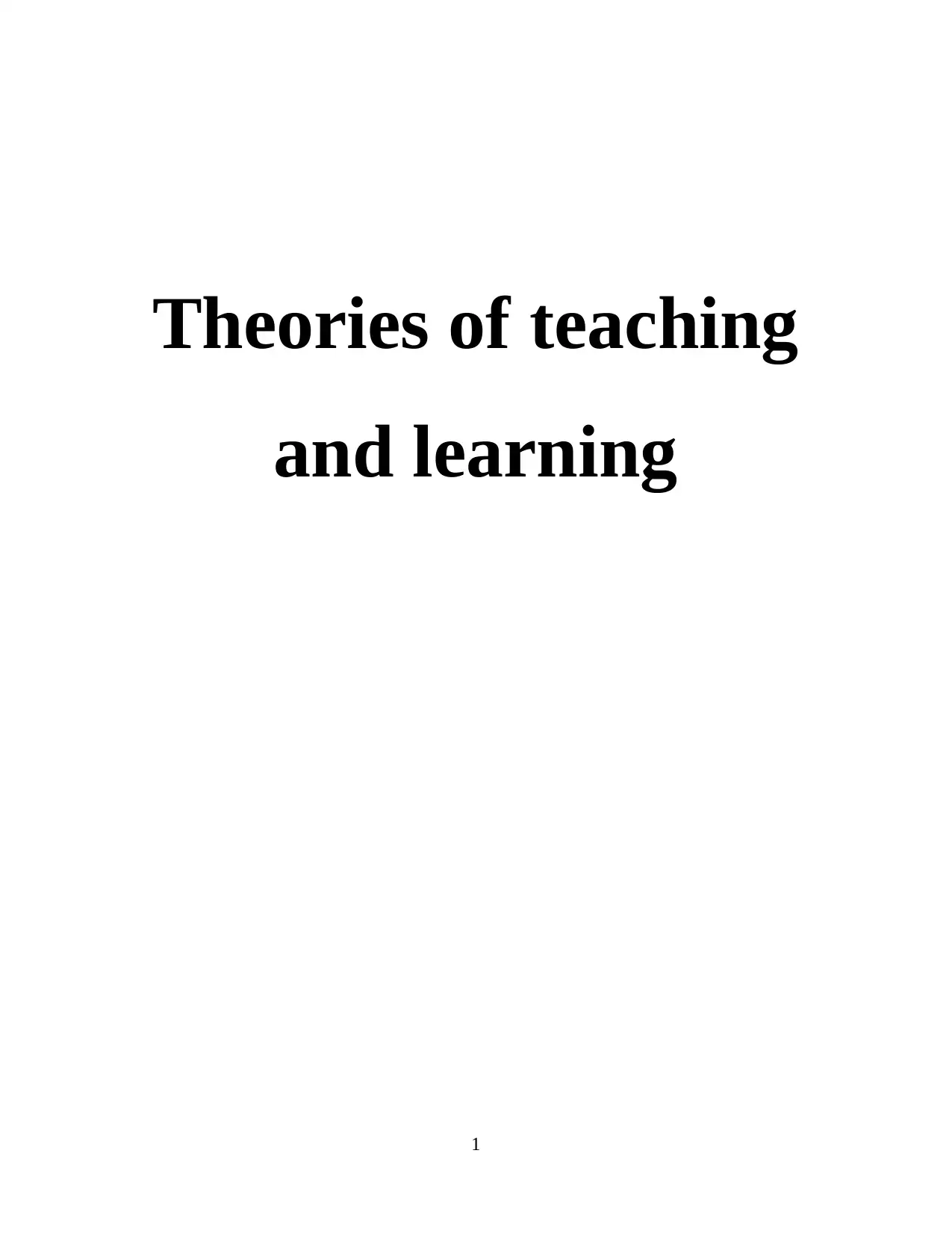
Theories of teaching
and learning
1
and learning
1
Secure Best Marks with AI Grader
Need help grading? Try our AI Grader for instant feedback on your assignments.
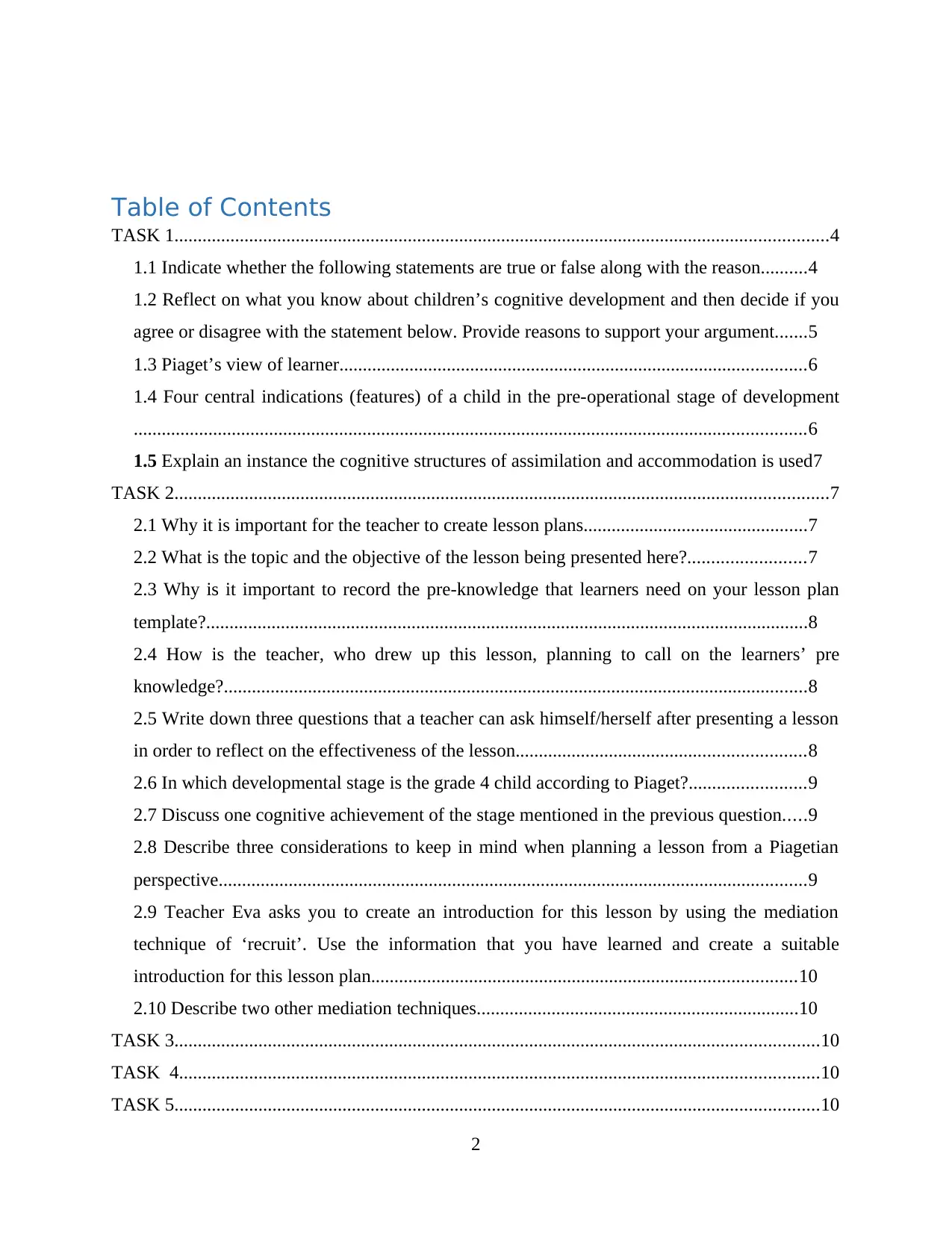
Table of Contents
TASK 1............................................................................................................................................4
1.1 Indicate whether the following statements are true or false along with the reason..........4
1.2 Reflect on what you know about children’s cognitive development and then decide if you
agree or disagree with the statement below. Provide reasons to support your argument.......5
1.3 Piaget’s view of learner....................................................................................................6
1.4 Four central indications (features) of a child in the pre-operational stage of development
................................................................................................................................................6
1.5 Explain an instance the cognitive structures of assimilation and accommodation is used7
TASK 2............................................................................................................................................7
2.1 Why it is important for the teacher to create lesson plans................................................7
2.2 What is the topic and the objective of the lesson being presented here?.........................7
2.3 Why is it important to record the pre-knowledge that learners need on your lesson plan
template?.................................................................................................................................8
2.4 How is the teacher, who drew up this lesson, planning to call on the learners’ pre
knowledge?.............................................................................................................................8
2.5 Write down three questions that a teacher can ask himself/herself after presenting a lesson
in order to reflect on the effectiveness of the lesson..............................................................8
2.6 In which developmental stage is the grade 4 child according to Piaget?.........................9
2.7 Discuss one cognitive achievement of the stage mentioned in the previous question.....9
2.8 Describe three considerations to keep in mind when planning a lesson from a Piagetian
perspective..............................................................................................................................9
2.9 Teacher Eva asks you to create an introduction for this lesson by using the mediation
technique of ‘recruit’. Use the information that you have learned and create a suitable
introduction for this lesson plan...........................................................................................10
2.10 Describe two other mediation techniques.....................................................................10
TASK 3..........................................................................................................................................10
TASK 4.........................................................................................................................................10
TASK 5..........................................................................................................................................10
2
TASK 1............................................................................................................................................4
1.1 Indicate whether the following statements are true or false along with the reason..........4
1.2 Reflect on what you know about children’s cognitive development and then decide if you
agree or disagree with the statement below. Provide reasons to support your argument.......5
1.3 Piaget’s view of learner....................................................................................................6
1.4 Four central indications (features) of a child in the pre-operational stage of development
................................................................................................................................................6
1.5 Explain an instance the cognitive structures of assimilation and accommodation is used7
TASK 2............................................................................................................................................7
2.1 Why it is important for the teacher to create lesson plans................................................7
2.2 What is the topic and the objective of the lesson being presented here?.........................7
2.3 Why is it important to record the pre-knowledge that learners need on your lesson plan
template?.................................................................................................................................8
2.4 How is the teacher, who drew up this lesson, planning to call on the learners’ pre
knowledge?.............................................................................................................................8
2.5 Write down three questions that a teacher can ask himself/herself after presenting a lesson
in order to reflect on the effectiveness of the lesson..............................................................8
2.6 In which developmental stage is the grade 4 child according to Piaget?.........................9
2.7 Discuss one cognitive achievement of the stage mentioned in the previous question.....9
2.8 Describe three considerations to keep in mind when planning a lesson from a Piagetian
perspective..............................................................................................................................9
2.9 Teacher Eva asks you to create an introduction for this lesson by using the mediation
technique of ‘recruit’. Use the information that you have learned and create a suitable
introduction for this lesson plan...........................................................................................10
2.10 Describe two other mediation techniques.....................................................................10
TASK 3..........................................................................................................................................10
TASK 4.........................................................................................................................................10
TASK 5..........................................................................................................................................10
2

REFERENCES..............................................................................................................................13
3
3
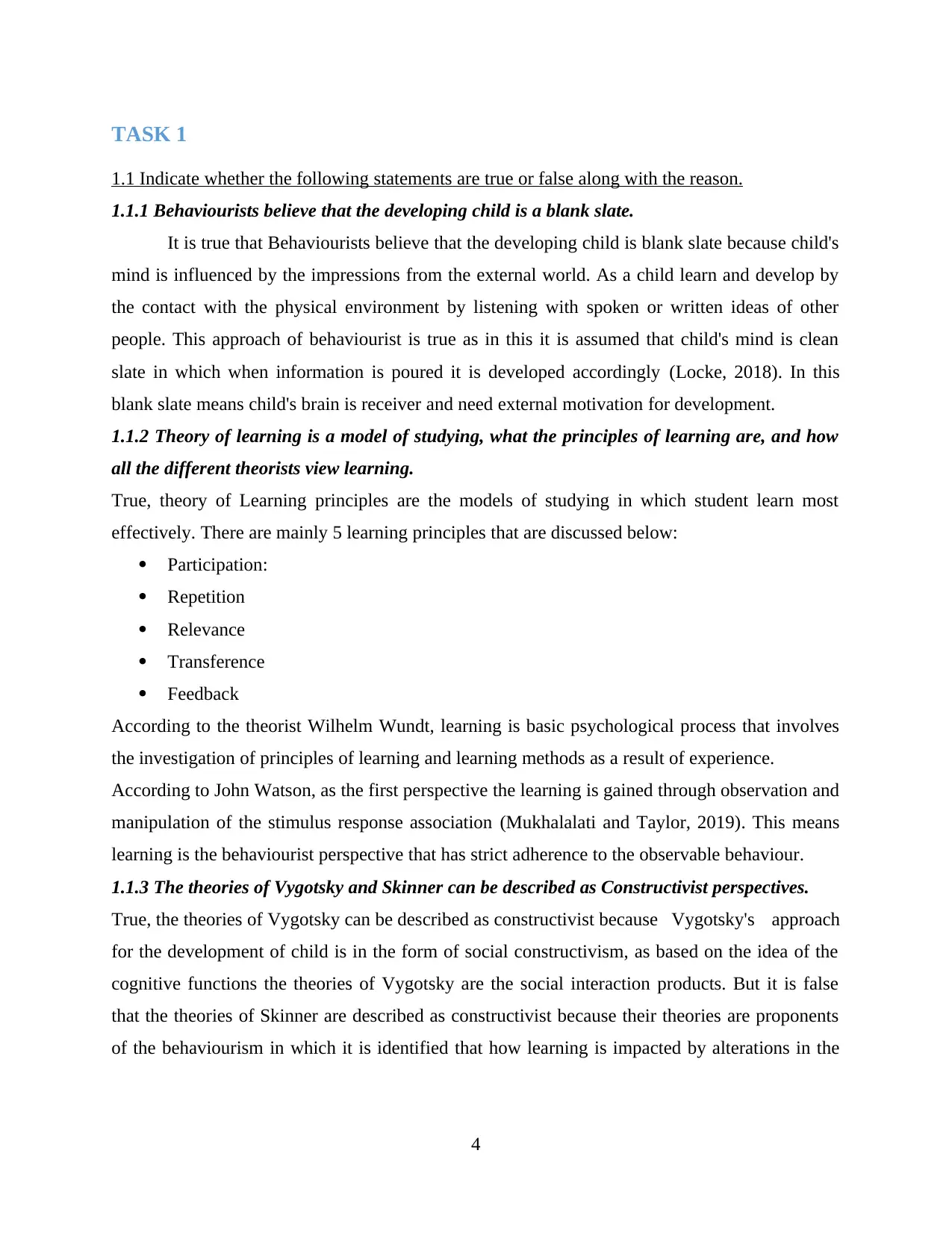
TASK 1
1.1 Indicate whether the following statements are true or false along with the reason.
1.1.1 Behaviourists believe that the developing child is a blank slate.
It is true that Behaviourists believe that the developing child is blank slate because child's
mind is influenced by the impressions from the external world. As a child learn and develop by
the contact with the physical environment by listening with spoken or written ideas of other
people. This approach of behaviourist is true as in this it is assumed that child's mind is clean
slate in which when information is poured it is developed accordingly (Locke, 2018). In this
blank slate means child's brain is receiver and need external motivation for development.
1.1.2 Theory of learning is a model of studying, what the principles of learning are, and how
all the different theorists view learning.
True, theory of Learning principles are the models of studying in which student learn most
effectively. There are mainly 5 learning principles that are discussed below:
Participation:
Repetition
Relevance
Transference
Feedback
According to the theorist Wilhelm Wundt, learning is basic psychological process that involves
the investigation of principles of learning and learning methods as a result of experience.
According to John Watson, as the first perspective the learning is gained through observation and
manipulation of the stimulus response association (Mukhalalati and Taylor, 2019). This means
learning is the behaviourist perspective that has strict adherence to the observable behaviour.
1.1.3 The theories of Vygotsky and Skinner can be described as Constructivist perspectives.
True, the theories of Vygotsky can be described as constructivist because Vygotsky's approach
for the development of child is in the form of social constructivism, as based on the idea of the
cognitive functions the theories of Vygotsky are the social interaction products. But it is false
that the theories of Skinner are described as constructivist because their theories are proponents
of the behaviourism in which it is identified that how learning is impacted by alterations in the
4
1.1 Indicate whether the following statements are true or false along with the reason.
1.1.1 Behaviourists believe that the developing child is a blank slate.
It is true that Behaviourists believe that the developing child is blank slate because child's
mind is influenced by the impressions from the external world. As a child learn and develop by
the contact with the physical environment by listening with spoken or written ideas of other
people. This approach of behaviourist is true as in this it is assumed that child's mind is clean
slate in which when information is poured it is developed accordingly (Locke, 2018). In this
blank slate means child's brain is receiver and need external motivation for development.
1.1.2 Theory of learning is a model of studying, what the principles of learning are, and how
all the different theorists view learning.
True, theory of Learning principles are the models of studying in which student learn most
effectively. There are mainly 5 learning principles that are discussed below:
Participation:
Repetition
Relevance
Transference
Feedback
According to the theorist Wilhelm Wundt, learning is basic psychological process that involves
the investigation of principles of learning and learning methods as a result of experience.
According to John Watson, as the first perspective the learning is gained through observation and
manipulation of the stimulus response association (Mukhalalati and Taylor, 2019). This means
learning is the behaviourist perspective that has strict adherence to the observable behaviour.
1.1.3 The theories of Vygotsky and Skinner can be described as Constructivist perspectives.
True, the theories of Vygotsky can be described as constructivist because Vygotsky's approach
for the development of child is in the form of social constructivism, as based on the idea of the
cognitive functions the theories of Vygotsky are the social interaction products. But it is false
that the theories of Skinner are described as constructivist because their theories are proponents
of the behaviourism in which it is identified that how learning is impacted by alterations in the
4
Secure Best Marks with AI Grader
Need help grading? Try our AI Grader for instant feedback on your assignments.
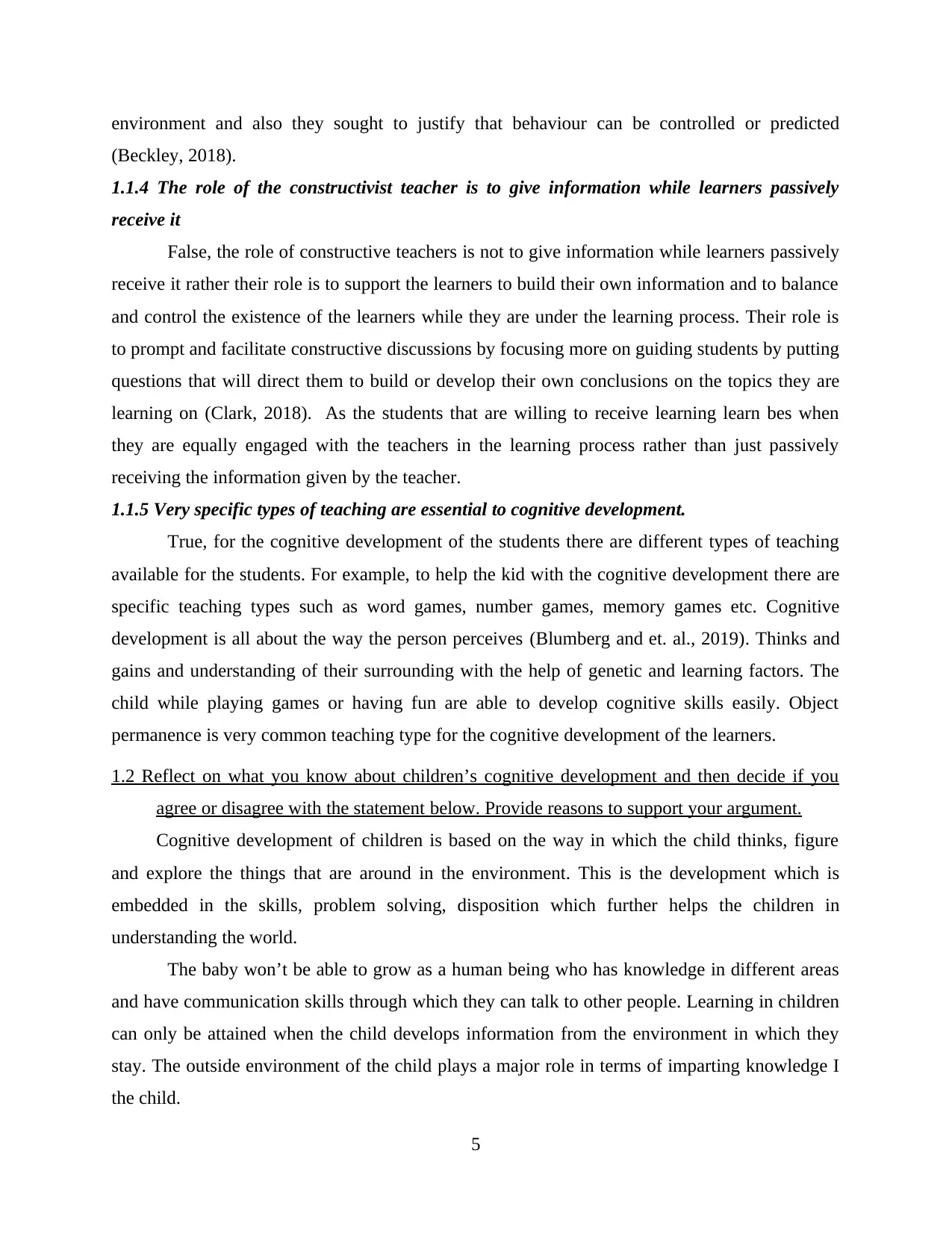
environment and also they sought to justify that behaviour can be controlled or predicted
(Beckley, 2018).
1.1.4 The role of the constructivist teacher is to give information while learners passively
receive it
False, the role of constructive teachers is not to give information while learners passively
receive it rather their role is to support the learners to build their own information and to balance
and control the existence of the learners while they are under the learning process. Their role is
to prompt and facilitate constructive discussions by focusing more on guiding students by putting
questions that will direct them to build or develop their own conclusions on the topics they are
learning on (Clark, 2018). As the students that are willing to receive learning learn bes when
they are equally engaged with the teachers in the learning process rather than just passively
receiving the information given by the teacher.
1.1.5 Very specific types of teaching are essential to cognitive development.
True, for the cognitive development of the students there are different types of teaching
available for the students. For example, to help the kid with the cognitive development there are
specific teaching types such as word games, number games, memory games etc. Cognitive
development is all about the way the person perceives (Blumberg and et. al., 2019). Thinks and
gains and understanding of their surrounding with the help of genetic and learning factors. The
child while playing games or having fun are able to develop cognitive skills easily. Object
permanence is very common teaching type for the cognitive development of the learners.
1.2 Reflect on what you know about children’s cognitive development and then decide if you
agree or disagree with the statement below. Provide reasons to support your argument.
Cognitive development of children is based on the way in which the child thinks, figure
and explore the things that are around in the environment. This is the development which is
embedded in the skills, problem solving, disposition which further helps the children in
understanding the world.
The baby won’t be able to grow as a human being who has knowledge in different areas
and have communication skills through which they can talk to other people. Learning in children
can only be attained when the child develops information from the environment in which they
stay. The outside environment of the child plays a major role in terms of imparting knowledge I
the child.
5
(Beckley, 2018).
1.1.4 The role of the constructivist teacher is to give information while learners passively
receive it
False, the role of constructive teachers is not to give information while learners passively
receive it rather their role is to support the learners to build their own information and to balance
and control the existence of the learners while they are under the learning process. Their role is
to prompt and facilitate constructive discussions by focusing more on guiding students by putting
questions that will direct them to build or develop their own conclusions on the topics they are
learning on (Clark, 2018). As the students that are willing to receive learning learn bes when
they are equally engaged with the teachers in the learning process rather than just passively
receiving the information given by the teacher.
1.1.5 Very specific types of teaching are essential to cognitive development.
True, for the cognitive development of the students there are different types of teaching
available for the students. For example, to help the kid with the cognitive development there are
specific teaching types such as word games, number games, memory games etc. Cognitive
development is all about the way the person perceives (Blumberg and et. al., 2019). Thinks and
gains and understanding of their surrounding with the help of genetic and learning factors. The
child while playing games or having fun are able to develop cognitive skills easily. Object
permanence is very common teaching type for the cognitive development of the learners.
1.2 Reflect on what you know about children’s cognitive development and then decide if you
agree or disagree with the statement below. Provide reasons to support your argument.
Cognitive development of children is based on the way in which the child thinks, figure
and explore the things that are around in the environment. This is the development which is
embedded in the skills, problem solving, disposition which further helps the children in
understanding the world.
The baby won’t be able to grow as a human being who has knowledge in different areas
and have communication skills through which they can talk to other people. Learning in children
can only be attained when the child develops information from the environment in which they
stay. The outside environment of the child plays a major role in terms of imparting knowledge I
the child.
5
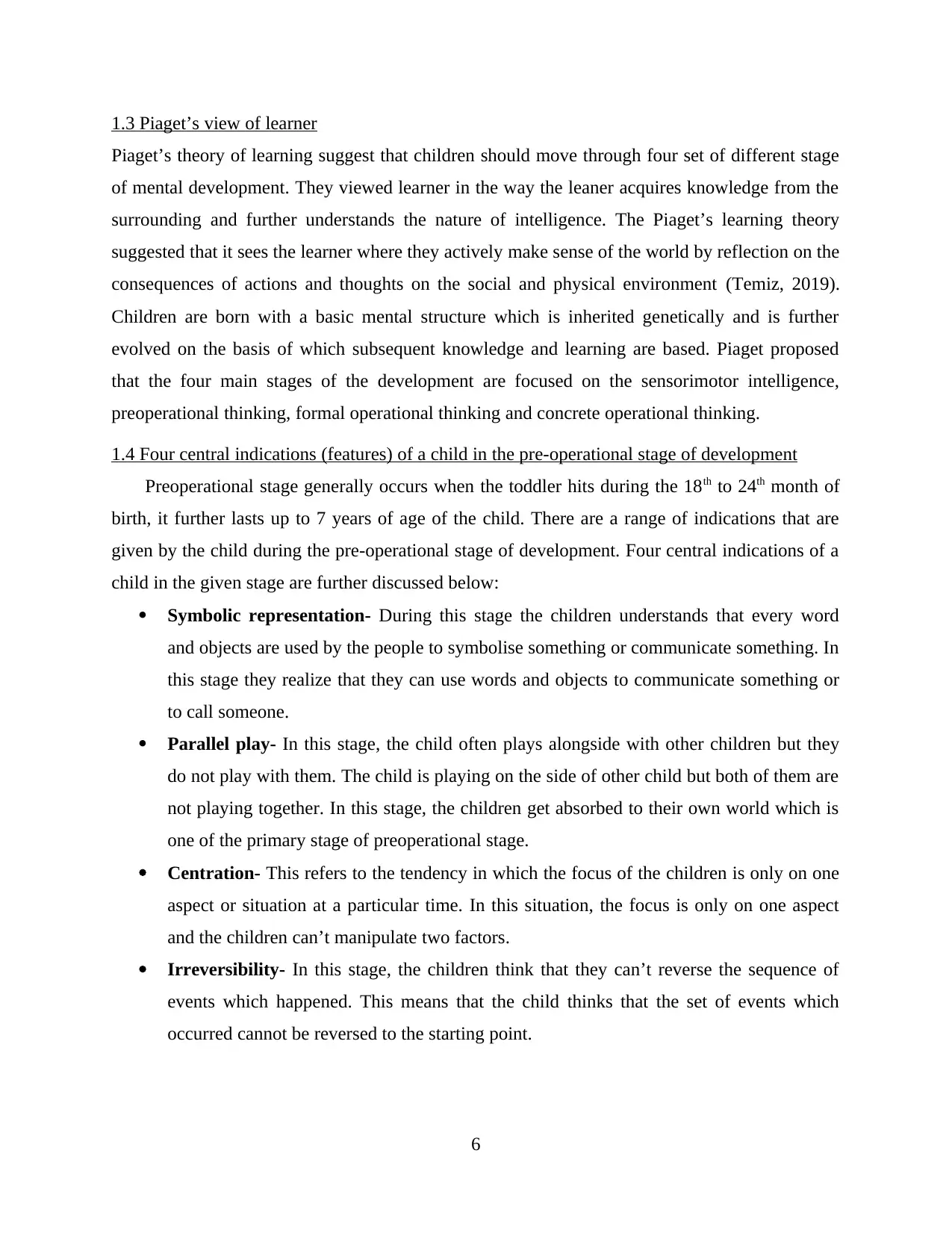
1.3 Piaget’s view of learner
Piaget’s theory of learning suggest that children should move through four set of different stage
of mental development. They viewed learner in the way the leaner acquires knowledge from the
surrounding and further understands the nature of intelligence. The Piaget’s learning theory
suggested that it sees the learner where they actively make sense of the world by reflection on the
consequences of actions and thoughts on the social and physical environment (Temiz, 2019).
Children are born with a basic mental structure which is inherited genetically and is further
evolved on the basis of which subsequent knowledge and learning are based. Piaget proposed
that the four main stages of the development are focused on the sensorimotor intelligence,
preoperational thinking, formal operational thinking and concrete operational thinking.
1.4 Four central indications (features) of a child in the pre-operational stage of development
Preoperational stage generally occurs when the toddler hits during the 18th to 24th month of
birth, it further lasts up to 7 years of age of the child. There are a range of indications that are
given by the child during the pre-operational stage of development. Four central indications of a
child in the given stage are further discussed below:
Symbolic representation- During this stage the children understands that every word
and objects are used by the people to symbolise something or communicate something. In
this stage they realize that they can use words and objects to communicate something or
to call someone.
Parallel play- In this stage, the child often plays alongside with other children but they
do not play with them. The child is playing on the side of other child but both of them are
not playing together. In this stage, the children get absorbed to their own world which is
one of the primary stage of preoperational stage.
Centration- This refers to the tendency in which the focus of the children is only on one
aspect or situation at a particular time. In this situation, the focus is only on one aspect
and the children can’t manipulate two factors.
Irreversibility- In this stage, the children think that they can’t reverse the sequence of
events which happened. This means that the child thinks that the set of events which
occurred cannot be reversed to the starting point.
6
Piaget’s theory of learning suggest that children should move through four set of different stage
of mental development. They viewed learner in the way the leaner acquires knowledge from the
surrounding and further understands the nature of intelligence. The Piaget’s learning theory
suggested that it sees the learner where they actively make sense of the world by reflection on the
consequences of actions and thoughts on the social and physical environment (Temiz, 2019).
Children are born with a basic mental structure which is inherited genetically and is further
evolved on the basis of which subsequent knowledge and learning are based. Piaget proposed
that the four main stages of the development are focused on the sensorimotor intelligence,
preoperational thinking, formal operational thinking and concrete operational thinking.
1.4 Four central indications (features) of a child in the pre-operational stage of development
Preoperational stage generally occurs when the toddler hits during the 18th to 24th month of
birth, it further lasts up to 7 years of age of the child. There are a range of indications that are
given by the child during the pre-operational stage of development. Four central indications of a
child in the given stage are further discussed below:
Symbolic representation- During this stage the children understands that every word
and objects are used by the people to symbolise something or communicate something. In
this stage they realize that they can use words and objects to communicate something or
to call someone.
Parallel play- In this stage, the child often plays alongside with other children but they
do not play with them. The child is playing on the side of other child but both of them are
not playing together. In this stage, the children get absorbed to their own world which is
one of the primary stage of preoperational stage.
Centration- This refers to the tendency in which the focus of the children is only on one
aspect or situation at a particular time. In this situation, the focus is only on one aspect
and the children can’t manipulate two factors.
Irreversibility- In this stage, the children think that they can’t reverse the sequence of
events which happened. This means that the child thinks that the set of events which
occurred cannot be reversed to the starting point.
6
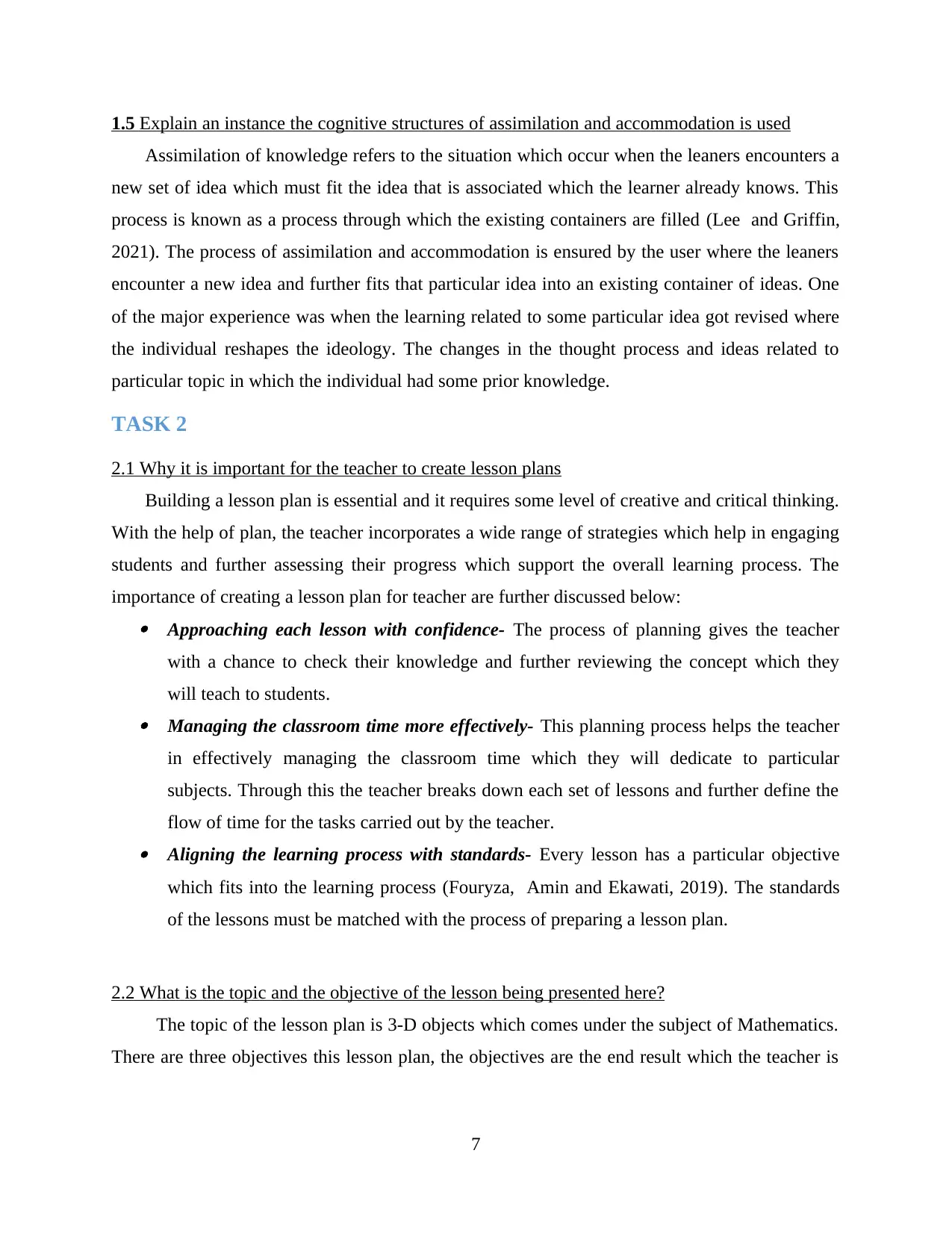
1.5 Explain an instance the cognitive structures of assimilation and accommodation is used
Assimilation of knowledge refers to the situation which occur when the leaners encounters a
new set of idea which must fit the idea that is associated which the learner already knows. This
process is known as a process through which the existing containers are filled (Lee and Griffin,
2021). The process of assimilation and accommodation is ensured by the user where the leaners
encounter a new idea and further fits that particular idea into an existing container of ideas. One
of the major experience was when the learning related to some particular idea got revised where
the individual reshapes the ideology. The changes in the thought process and ideas related to
particular topic in which the individual had some prior knowledge.
TASK 2
2.1 Why it is important for the teacher to create lesson plans
Building a lesson plan is essential and it requires some level of creative and critical thinking.
With the help of plan, the teacher incorporates a wide range of strategies which help in engaging
students and further assessing their progress which support the overall learning process. The
importance of creating a lesson plan for teacher are further discussed below: Approaching each lesson with confidence- The process of planning gives the teacher
with a chance to check their knowledge and further reviewing the concept which they
will teach to students. Managing the classroom time more effectively- This planning process helps the teacher
in effectively managing the classroom time which they will dedicate to particular
subjects. Through this the teacher breaks down each set of lessons and further define the
flow of time for the tasks carried out by the teacher. Aligning the learning process with standards- Every lesson has a particular objective
which fits into the learning process (Fouryza, Amin and Ekawati, 2019). The standards
of the lessons must be matched with the process of preparing a lesson plan.
2.2 What is the topic and the objective of the lesson being presented here?
The topic of the lesson plan is 3-D objects which comes under the subject of Mathematics.
There are three objectives this lesson plan, the objectives are the end result which the teacher is
7
Assimilation of knowledge refers to the situation which occur when the leaners encounters a
new set of idea which must fit the idea that is associated which the learner already knows. This
process is known as a process through which the existing containers are filled (Lee and Griffin,
2021). The process of assimilation and accommodation is ensured by the user where the leaners
encounter a new idea and further fits that particular idea into an existing container of ideas. One
of the major experience was when the learning related to some particular idea got revised where
the individual reshapes the ideology. The changes in the thought process and ideas related to
particular topic in which the individual had some prior knowledge.
TASK 2
2.1 Why it is important for the teacher to create lesson plans
Building a lesson plan is essential and it requires some level of creative and critical thinking.
With the help of plan, the teacher incorporates a wide range of strategies which help in engaging
students and further assessing their progress which support the overall learning process. The
importance of creating a lesson plan for teacher are further discussed below: Approaching each lesson with confidence- The process of planning gives the teacher
with a chance to check their knowledge and further reviewing the concept which they
will teach to students. Managing the classroom time more effectively- This planning process helps the teacher
in effectively managing the classroom time which they will dedicate to particular
subjects. Through this the teacher breaks down each set of lessons and further define the
flow of time for the tasks carried out by the teacher. Aligning the learning process with standards- Every lesson has a particular objective
which fits into the learning process (Fouryza, Amin and Ekawati, 2019). The standards
of the lessons must be matched with the process of preparing a lesson plan.
2.2 What is the topic and the objective of the lesson being presented here?
The topic of the lesson plan is 3-D objects which comes under the subject of Mathematics.
There are three objectives this lesson plan, the objectives are the end result which the teacher is
7
Paraphrase This Document
Need a fresh take? Get an instant paraphrase of this document with our AI Paraphraser
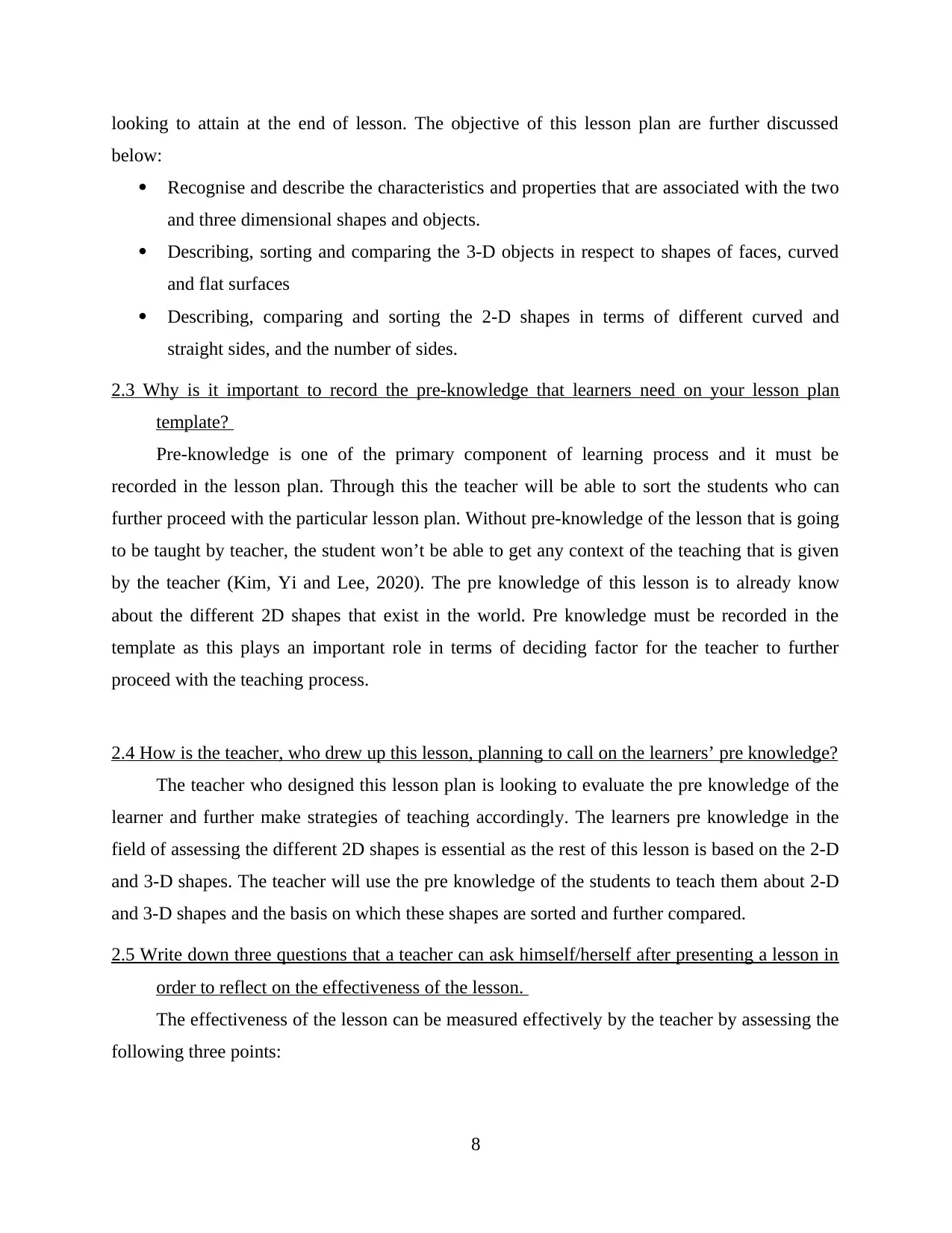
looking to attain at the end of lesson. The objective of this lesson plan are further discussed
below:
Recognise and describe the characteristics and properties that are associated with the two
and three dimensional shapes and objects.
Describing, sorting and comparing the 3-D objects in respect to shapes of faces, curved
and flat surfaces
Describing, comparing and sorting the 2-D shapes in terms of different curved and
straight sides, and the number of sides.
2.3 Why is it important to record the pre-knowledge that learners need on your lesson plan
template?
Pre-knowledge is one of the primary component of learning process and it must be
recorded in the lesson plan. Through this the teacher will be able to sort the students who can
further proceed with the particular lesson plan. Without pre-knowledge of the lesson that is going
to be taught by teacher, the student won’t be able to get any context of the teaching that is given
by the teacher (Kim, Yi and Lee, 2020). The pre knowledge of this lesson is to already know
about the different 2D shapes that exist in the world. Pre knowledge must be recorded in the
template as this plays an important role in terms of deciding factor for the teacher to further
proceed with the teaching process.
2.4 How is the teacher, who drew up this lesson, planning to call on the learners’ pre knowledge?
The teacher who designed this lesson plan is looking to evaluate the pre knowledge of the
learner and further make strategies of teaching accordingly. The learners pre knowledge in the
field of assessing the different 2D shapes is essential as the rest of this lesson is based on the 2-D
and 3-D shapes. The teacher will use the pre knowledge of the students to teach them about 2-D
and 3-D shapes and the basis on which these shapes are sorted and further compared.
2.5 Write down three questions that a teacher can ask himself/herself after presenting a lesson in
order to reflect on the effectiveness of the lesson.
The effectiveness of the lesson can be measured effectively by the teacher by assessing the
following three points:
8
below:
Recognise and describe the characteristics and properties that are associated with the two
and three dimensional shapes and objects.
Describing, sorting and comparing the 3-D objects in respect to shapes of faces, curved
and flat surfaces
Describing, comparing and sorting the 2-D shapes in terms of different curved and
straight sides, and the number of sides.
2.3 Why is it important to record the pre-knowledge that learners need on your lesson plan
template?
Pre-knowledge is one of the primary component of learning process and it must be
recorded in the lesson plan. Through this the teacher will be able to sort the students who can
further proceed with the particular lesson plan. Without pre-knowledge of the lesson that is going
to be taught by teacher, the student won’t be able to get any context of the teaching that is given
by the teacher (Kim, Yi and Lee, 2020). The pre knowledge of this lesson is to already know
about the different 2D shapes that exist in the world. Pre knowledge must be recorded in the
template as this plays an important role in terms of deciding factor for the teacher to further
proceed with the teaching process.
2.4 How is the teacher, who drew up this lesson, planning to call on the learners’ pre knowledge?
The teacher who designed this lesson plan is looking to evaluate the pre knowledge of the
learner and further make strategies of teaching accordingly. The learners pre knowledge in the
field of assessing the different 2D shapes is essential as the rest of this lesson is based on the 2-D
and 3-D shapes. The teacher will use the pre knowledge of the students to teach them about 2-D
and 3-D shapes and the basis on which these shapes are sorted and further compared.
2.5 Write down three questions that a teacher can ask himself/herself after presenting a lesson in
order to reflect on the effectiveness of the lesson.
The effectiveness of the lesson can be measured effectively by the teacher by assessing the
following three points:
8
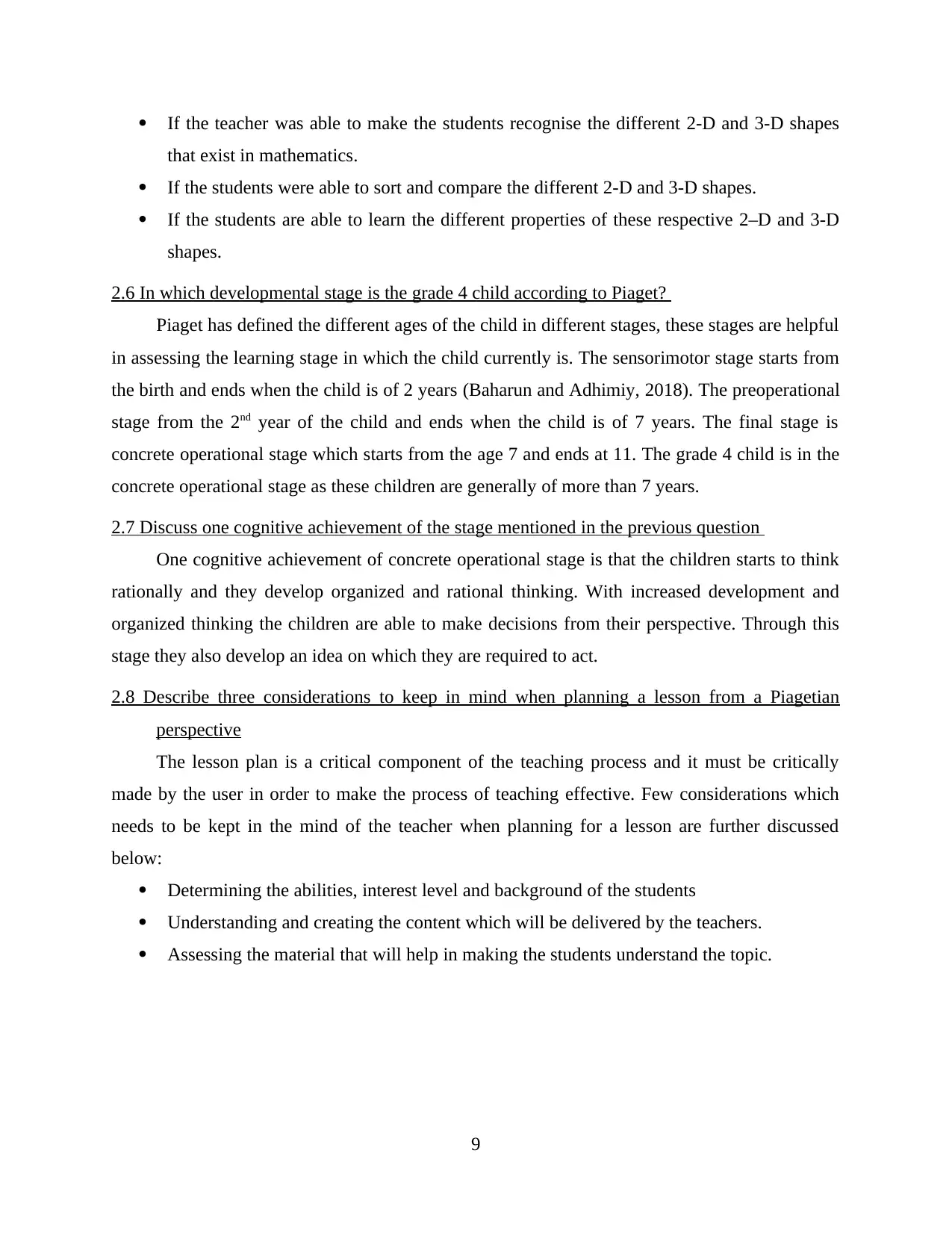
If the teacher was able to make the students recognise the different 2-D and 3-D shapes
that exist in mathematics.
If the students were able to sort and compare the different 2-D and 3-D shapes.
If the students are able to learn the different properties of these respective 2–D and 3-D
shapes.
2.6 In which developmental stage is the grade 4 child according to Piaget?
Piaget has defined the different ages of the child in different stages, these stages are helpful
in assessing the learning stage in which the child currently is. The sensorimotor stage starts from
the birth and ends when the child is of 2 years (Baharun and Adhimiy, 2018). The preoperational
stage from the 2nd year of the child and ends when the child is of 7 years. The final stage is
concrete operational stage which starts from the age 7 and ends at 11. The grade 4 child is in the
concrete operational stage as these children are generally of more than 7 years.
2.7 Discuss one cognitive achievement of the stage mentioned in the previous question
One cognitive achievement of concrete operational stage is that the children starts to think
rationally and they develop organized and rational thinking. With increased development and
organized thinking the children are able to make decisions from their perspective. Through this
stage they also develop an idea on which they are required to act.
2.8 Describe three considerations to keep in mind when planning a lesson from a Piagetian
perspective
The lesson plan is a critical component of the teaching process and it must be critically
made by the user in order to make the process of teaching effective. Few considerations which
needs to be kept in the mind of the teacher when planning for a lesson are further discussed
below:
Determining the abilities, interest level and background of the students
Understanding and creating the content which will be delivered by the teachers.
Assessing the material that will help in making the students understand the topic.
9
that exist in mathematics.
If the students were able to sort and compare the different 2-D and 3-D shapes.
If the students are able to learn the different properties of these respective 2–D and 3-D
shapes.
2.6 In which developmental stage is the grade 4 child according to Piaget?
Piaget has defined the different ages of the child in different stages, these stages are helpful
in assessing the learning stage in which the child currently is. The sensorimotor stage starts from
the birth and ends when the child is of 2 years (Baharun and Adhimiy, 2018). The preoperational
stage from the 2nd year of the child and ends when the child is of 7 years. The final stage is
concrete operational stage which starts from the age 7 and ends at 11. The grade 4 child is in the
concrete operational stage as these children are generally of more than 7 years.
2.7 Discuss one cognitive achievement of the stage mentioned in the previous question
One cognitive achievement of concrete operational stage is that the children starts to think
rationally and they develop organized and rational thinking. With increased development and
organized thinking the children are able to make decisions from their perspective. Through this
stage they also develop an idea on which they are required to act.
2.8 Describe three considerations to keep in mind when planning a lesson from a Piagetian
perspective
The lesson plan is a critical component of the teaching process and it must be critically
made by the user in order to make the process of teaching effective. Few considerations which
needs to be kept in the mind of the teacher when planning for a lesson are further discussed
below:
Determining the abilities, interest level and background of the students
Understanding and creating the content which will be delivered by the teachers.
Assessing the material that will help in making the students understand the topic.
9
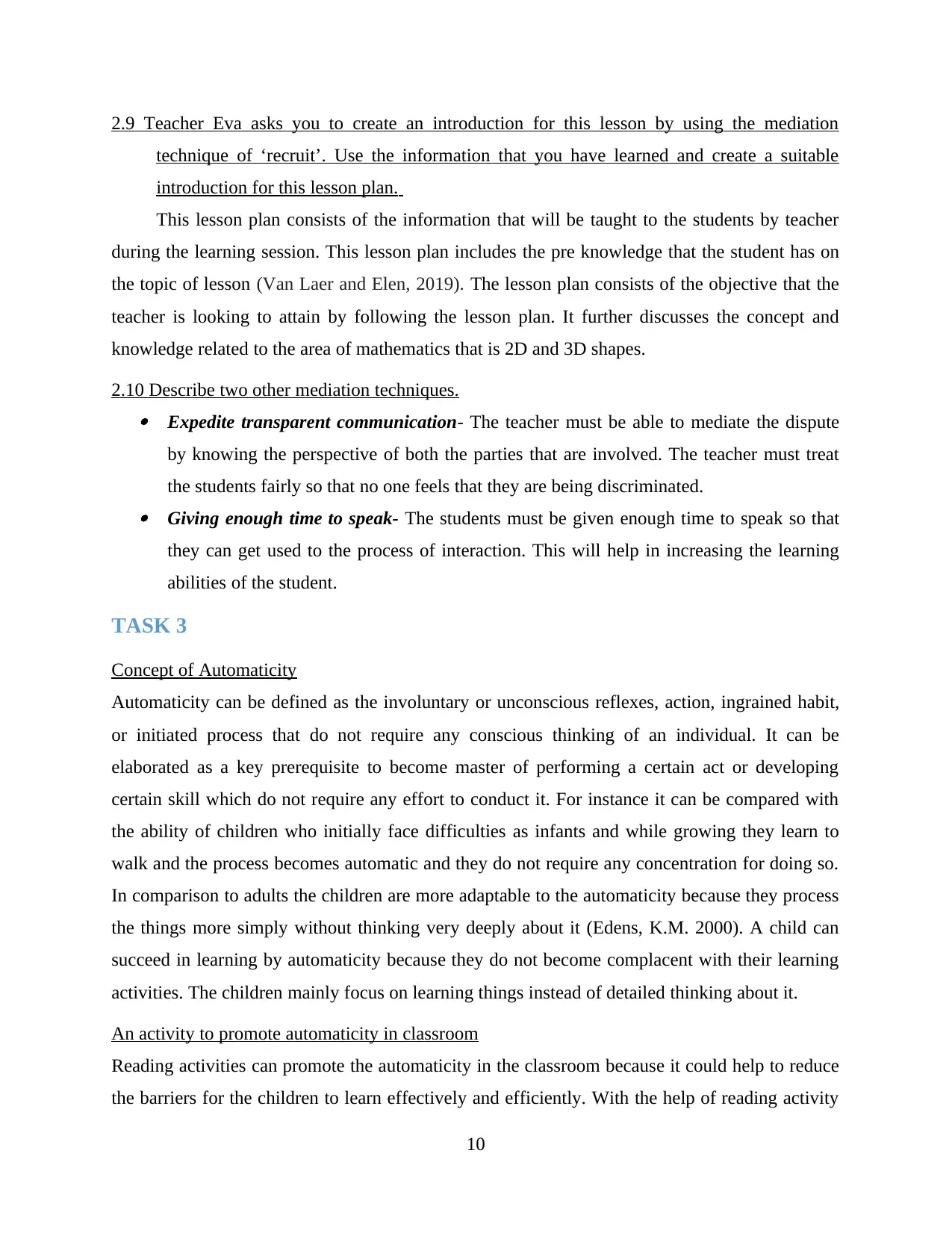
2.9 Teacher Eva asks you to create an introduction for this lesson by using the mediation
technique of ‘recruit’. Use the information that you have learned and create a suitable
introduction for this lesson plan.
This lesson plan consists of the information that will be taught to the students by teacher
during the learning session. This lesson plan includes the pre knowledge that the student has on
the topic of lesson (Van Laer and Elen, 2019). The lesson plan consists of the objective that the
teacher is looking to attain by following the lesson plan. It further discusses the concept and
knowledge related to the area of mathematics that is 2D and 3D shapes.
2.10 Describe two other mediation techniques. Expedite transparent communication- The teacher must be able to mediate the dispute
by knowing the perspective of both the parties that are involved. The teacher must treat
the students fairly so that no one feels that they are being discriminated. Giving enough time to speak- The students must be given enough time to speak so that
they can get used to the process of interaction. This will help in increasing the learning
abilities of the student.
TASK 3
Concept of Automaticity
Automaticity can be defined as the involuntary or unconscious reflexes, action, ingrained habit,
or initiated process that do not require any conscious thinking of an individual. It can be
elaborated as a key prerequisite to become master of performing a certain act or developing
certain skill which do not require any effort to conduct it. For instance it can be compared with
the ability of children who initially face difficulties as infants and while growing they learn to
walk and the process becomes automatic and they do not require any concentration for doing so.
In comparison to adults the children are more adaptable to the automaticity because they process
the things more simply without thinking very deeply about it (Edens, K.M. 2000). A child can
succeed in learning by automaticity because they do not become complacent with their learning
activities. The children mainly focus on learning things instead of detailed thinking about it.
An activity to promote automaticity in classroom
Reading activities can promote the automaticity in the classroom because it could help to reduce
the barriers for the children to learn effectively and efficiently. With the help of reading activity
10
technique of ‘recruit’. Use the information that you have learned and create a suitable
introduction for this lesson plan.
This lesson plan consists of the information that will be taught to the students by teacher
during the learning session. This lesson plan includes the pre knowledge that the student has on
the topic of lesson (Van Laer and Elen, 2019). The lesson plan consists of the objective that the
teacher is looking to attain by following the lesson plan. It further discusses the concept and
knowledge related to the area of mathematics that is 2D and 3D shapes.
2.10 Describe two other mediation techniques. Expedite transparent communication- The teacher must be able to mediate the dispute
by knowing the perspective of both the parties that are involved. The teacher must treat
the students fairly so that no one feels that they are being discriminated. Giving enough time to speak- The students must be given enough time to speak so that
they can get used to the process of interaction. This will help in increasing the learning
abilities of the student.
TASK 3
Concept of Automaticity
Automaticity can be defined as the involuntary or unconscious reflexes, action, ingrained habit,
or initiated process that do not require any conscious thinking of an individual. It can be
elaborated as a key prerequisite to become master of performing a certain act or developing
certain skill which do not require any effort to conduct it. For instance it can be compared with
the ability of children who initially face difficulties as infants and while growing they learn to
walk and the process becomes automatic and they do not require any concentration for doing so.
In comparison to adults the children are more adaptable to the automaticity because they process
the things more simply without thinking very deeply about it (Edens, K.M. 2000). A child can
succeed in learning by automaticity because they do not become complacent with their learning
activities. The children mainly focus on learning things instead of detailed thinking about it.
An activity to promote automaticity in classroom
Reading activities can promote the automaticity in the classroom because it could help to reduce
the barriers for the children to learn effectively and efficiently. With the help of reading activity
10
Secure Best Marks with AI Grader
Need help grading? Try our AI Grader for instant feedback on your assignments.
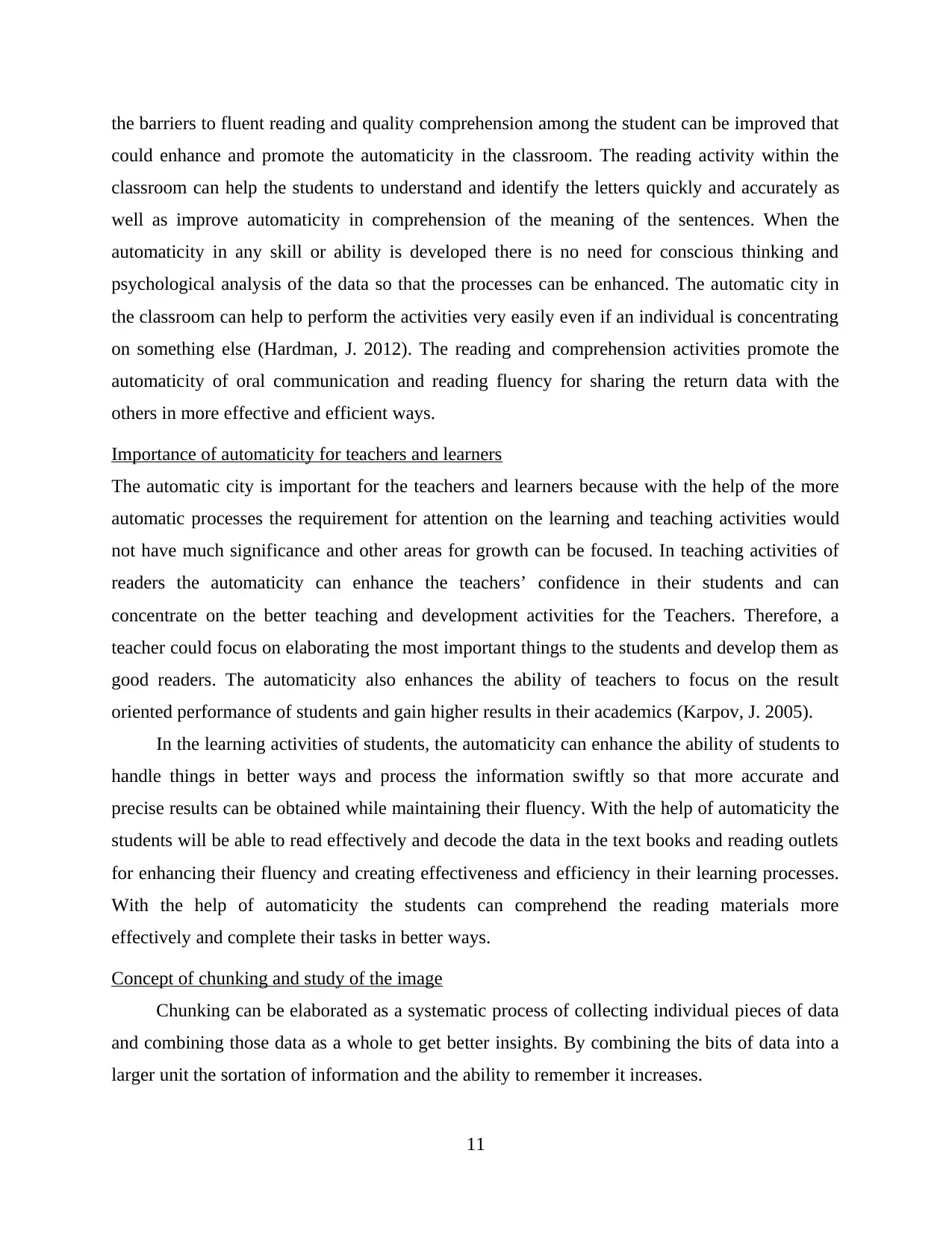
the barriers to fluent reading and quality comprehension among the student can be improved that
could enhance and promote the automaticity in the classroom. The reading activity within the
classroom can help the students to understand and identify the letters quickly and accurately as
well as improve automaticity in comprehension of the meaning of the sentences. When the
automaticity in any skill or ability is developed there is no need for conscious thinking and
psychological analysis of the data so that the processes can be enhanced. The automatic city in
the classroom can help to perform the activities very easily even if an individual is concentrating
on something else (Hardman, J. 2012). The reading and comprehension activities promote the
automaticity of oral communication and reading fluency for sharing the return data with the
others in more effective and efficient ways.
Importance of automaticity for teachers and learners
The automatic city is important for the teachers and learners because with the help of the more
automatic processes the requirement for attention on the learning and teaching activities would
not have much significance and other areas for growth can be focused. In teaching activities of
readers the automaticity can enhance the teachers’ confidence in their students and can
concentrate on the better teaching and development activities for the Teachers. Therefore, a
teacher could focus on elaborating the most important things to the students and develop them as
good readers. The automaticity also enhances the ability of teachers to focus on the result
oriented performance of students and gain higher results in their academics (Karpov, J. 2005).
In the learning activities of students, the automaticity can enhance the ability of students to
handle things in better ways and process the information swiftly so that more accurate and
precise results can be obtained while maintaining their fluency. With the help of automaticity the
students will be able to read effectively and decode the data in the text books and reading outlets
for enhancing their fluency and creating effectiveness and efficiency in their learning processes.
With the help of automaticity the students can comprehend the reading materials more
effectively and complete their tasks in better ways.
Concept of chunking and study of the image
Chunking can be elaborated as a systematic process of collecting individual pieces of data
and combining those data as a whole to get better insights. By combining the bits of data into a
larger unit the sortation of information and the ability to remember it increases.
11
could enhance and promote the automaticity in the classroom. The reading activity within the
classroom can help the students to understand and identify the letters quickly and accurately as
well as improve automaticity in comprehension of the meaning of the sentences. When the
automaticity in any skill or ability is developed there is no need for conscious thinking and
psychological analysis of the data so that the processes can be enhanced. The automatic city in
the classroom can help to perform the activities very easily even if an individual is concentrating
on something else (Hardman, J. 2012). The reading and comprehension activities promote the
automaticity of oral communication and reading fluency for sharing the return data with the
others in more effective and efficient ways.
Importance of automaticity for teachers and learners
The automatic city is important for the teachers and learners because with the help of the more
automatic processes the requirement for attention on the learning and teaching activities would
not have much significance and other areas for growth can be focused. In teaching activities of
readers the automaticity can enhance the teachers’ confidence in their students and can
concentrate on the better teaching and development activities for the Teachers. Therefore, a
teacher could focus on elaborating the most important things to the students and develop them as
good readers. The automaticity also enhances the ability of teachers to focus on the result
oriented performance of students and gain higher results in their academics (Karpov, J. 2005).
In the learning activities of students, the automaticity can enhance the ability of students to
handle things in better ways and process the information swiftly so that more accurate and
precise results can be obtained while maintaining their fluency. With the help of automaticity the
students will be able to read effectively and decode the data in the text books and reading outlets
for enhancing their fluency and creating effectiveness and efficiency in their learning processes.
With the help of automaticity the students can comprehend the reading materials more
effectively and complete their tasks in better ways.
Concept of chunking and study of the image
Chunking can be elaborated as a systematic process of collecting individual pieces of data
and combining those data as a whole to get better insights. By combining the bits of data into a
larger unit the sortation of information and the ability to remember it increases.
11
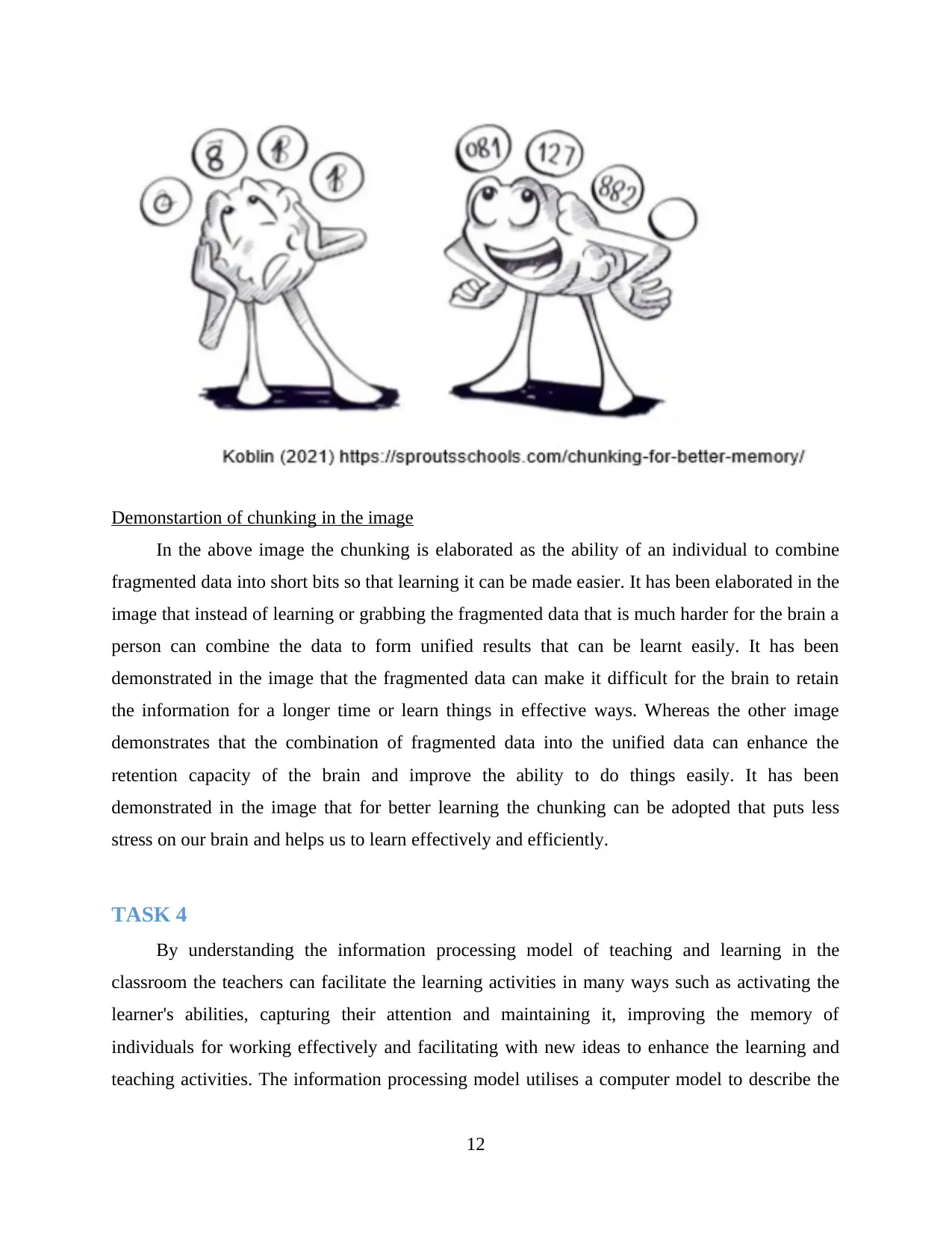
Demonstartion of chunking in the image
In the above image the chunking is elaborated as the ability of an individual to combine
fragmented data into short bits so that learning it can be made easier. It has been elaborated in the
image that instead of learning or grabbing the fragmented data that is much harder for the brain a
person can combine the data to form unified results that can be learnt easily. It has been
demonstrated in the image that the fragmented data can make it difficult for the brain to retain
the information for a longer time or learn things in effective ways. Whereas the other image
demonstrates that the combination of fragmented data into the unified data can enhance the
retention capacity of the brain and improve the ability to do things easily. It has been
demonstrated in the image that for better learning the chunking can be adopted that puts less
stress on our brain and helps us to learn effectively and efficiently.
TASK 4
By understanding the information processing model of teaching and learning in the
classroom the teachers can facilitate the learning activities in many ways such as activating the
learner's abilities, capturing their attention and maintaining it, improving the memory of
individuals for working effectively and facilitating with new ideas to enhance the learning and
teaching activities. The information processing model utilises a computer model to describe the
12
In the above image the chunking is elaborated as the ability of an individual to combine
fragmented data into short bits so that learning it can be made easier. It has been elaborated in the
image that instead of learning or grabbing the fragmented data that is much harder for the brain a
person can combine the data to form unified results that can be learnt easily. It has been
demonstrated in the image that the fragmented data can make it difficult for the brain to retain
the information for a longer time or learn things in effective ways. Whereas the other image
demonstrates that the combination of fragmented data into the unified data can enhance the
retention capacity of the brain and improve the ability to do things easily. It has been
demonstrated in the image that for better learning the chunking can be adopted that puts less
stress on our brain and helps us to learn effectively and efficiently.
TASK 4
By understanding the information processing model of teaching and learning in the
classroom the teachers can facilitate the learning activities in many ways such as activating the
learner's abilities, capturing their attention and maintaining it, improving the memory of
individuals for working effectively and facilitating with new ideas to enhance the learning and
teaching activities. The information processing model utilises a computer model to describe the
12
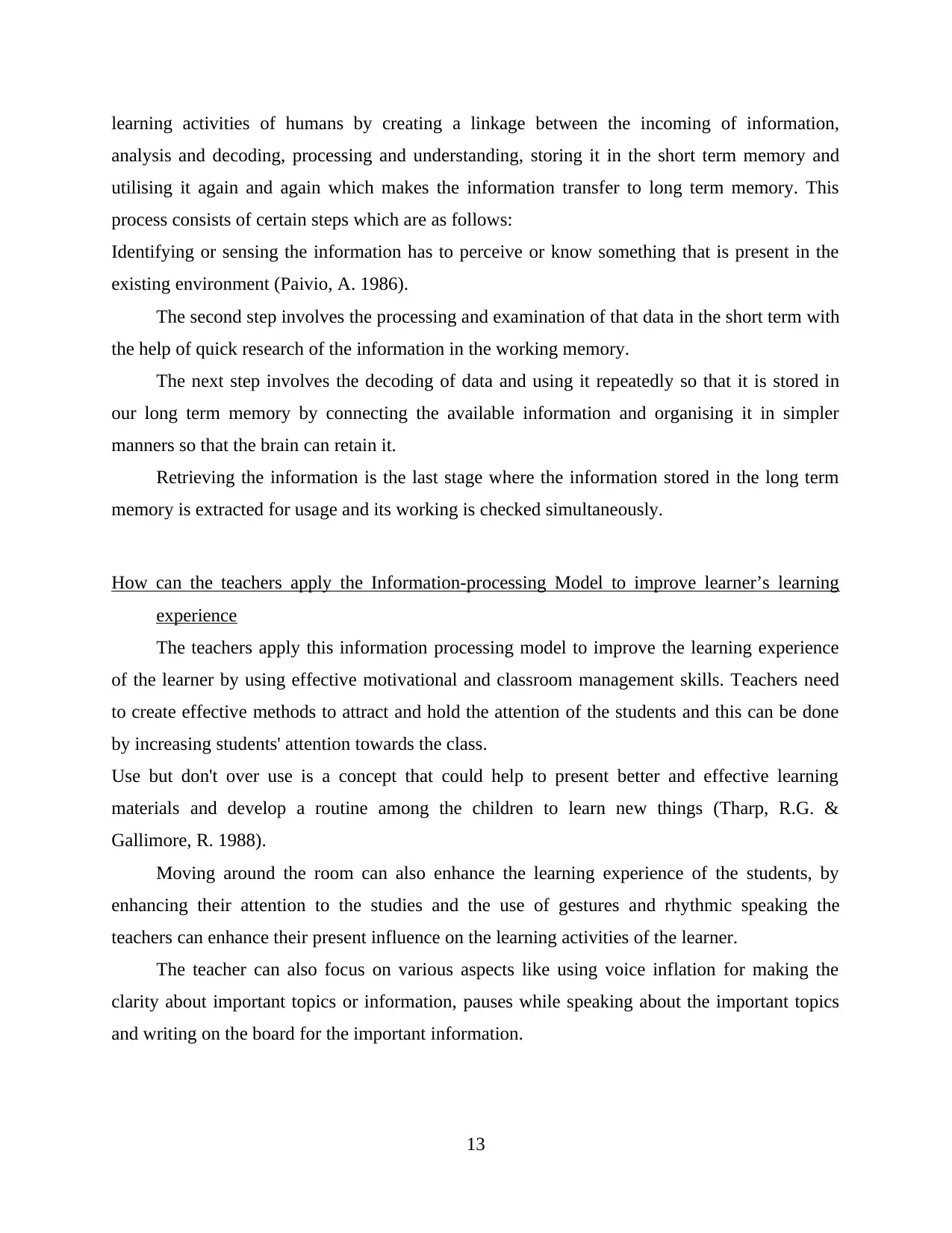
learning activities of humans by creating a linkage between the incoming of information,
analysis and decoding, processing and understanding, storing it in the short term memory and
utilising it again and again which makes the information transfer to long term memory. This
process consists of certain steps which are as follows:
Identifying or sensing the information has to perceive or know something that is present in the
existing environment (Paivio, A. 1986).
The second step involves the processing and examination of that data in the short term with
the help of quick research of the information in the working memory.
The next step involves the decoding of data and using it repeatedly so that it is stored in
our long term memory by connecting the available information and organising it in simpler
manners so that the brain can retain it.
Retrieving the information is the last stage where the information stored in the long term
memory is extracted for usage and its working is checked simultaneously.
How can the teachers apply the Information-processing Model to improve learner’s learning
experience
The teachers apply this information processing model to improve the learning experience
of the learner by using effective motivational and classroom management skills. Teachers need
to create effective methods to attract and hold the attention of the students and this can be done
by increasing students' attention towards the class.
Use but don't over use is a concept that could help to present better and effective learning
materials and develop a routine among the children to learn new things (Tharp, R.G. &
Gallimore, R. 1988).
Moving around the room can also enhance the learning experience of the students, by
enhancing their attention to the studies and the use of gestures and rhythmic speaking the
teachers can enhance their present influence on the learning activities of the learner.
The teacher can also focus on various aspects like using voice inflation for making the
clarity about important topics or information, pauses while speaking about the important topics
and writing on the board for the important information.
13
analysis and decoding, processing and understanding, storing it in the short term memory and
utilising it again and again which makes the information transfer to long term memory. This
process consists of certain steps which are as follows:
Identifying or sensing the information has to perceive or know something that is present in the
existing environment (Paivio, A. 1986).
The second step involves the processing and examination of that data in the short term with
the help of quick research of the information in the working memory.
The next step involves the decoding of data and using it repeatedly so that it is stored in
our long term memory by connecting the available information and organising it in simpler
manners so that the brain can retain it.
Retrieving the information is the last stage where the information stored in the long term
memory is extracted for usage and its working is checked simultaneously.
How can the teachers apply the Information-processing Model to improve learner’s learning
experience
The teachers apply this information processing model to improve the learning experience
of the learner by using effective motivational and classroom management skills. Teachers need
to create effective methods to attract and hold the attention of the students and this can be done
by increasing students' attention towards the class.
Use but don't over use is a concept that could help to present better and effective learning
materials and develop a routine among the children to learn new things (Tharp, R.G. &
Gallimore, R. 1988).
Moving around the room can also enhance the learning experience of the students, by
enhancing their attention to the studies and the use of gestures and rhythmic speaking the
teachers can enhance their present influence on the learning activities of the learner.
The teacher can also focus on various aspects like using voice inflation for making the
clarity about important topics or information, pauses while speaking about the important topics
and writing on the board for the important information.
13
Paraphrase This Document
Need a fresh take? Get an instant paraphrase of this document with our AI Paraphraser
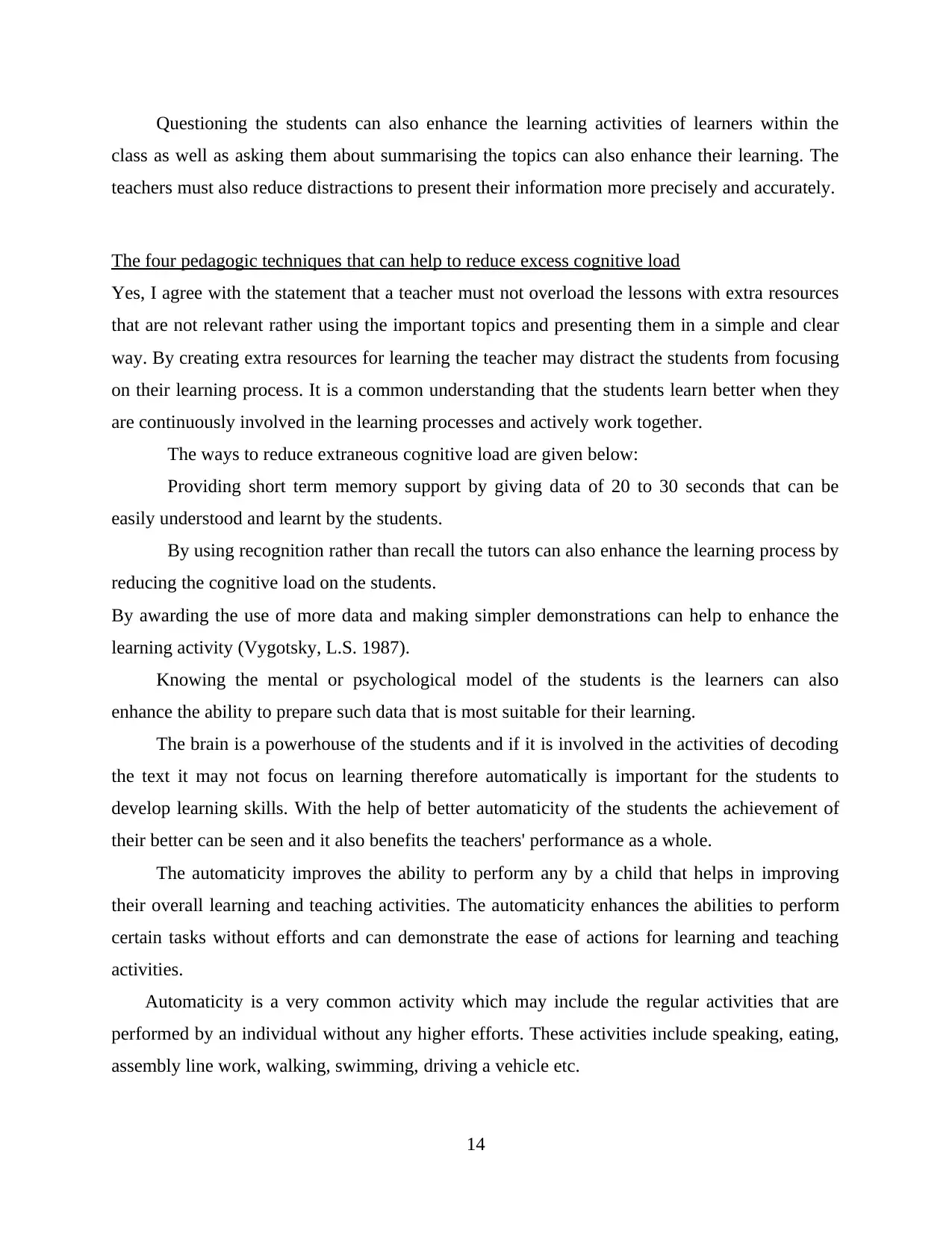
Questioning the students can also enhance the learning activities of learners within the
class as well as asking them about summarising the topics can also enhance their learning. The
teachers must also reduce distractions to present their information more precisely and accurately.
The four pedagogic techniques that can help to reduce excess cognitive load
Yes, I agree with the statement that a teacher must not overload the lessons with extra resources
that are not relevant rather using the important topics and presenting them in a simple and clear
way. By creating extra resources for learning the teacher may distract the students from focusing
on their learning process. It is a common understanding that the students learn better when they
are continuously involved in the learning processes and actively work together.
The ways to reduce extraneous cognitive load are given below:
Providing short term memory support by giving data of 20 to 30 seconds that can be
easily understood and learnt by the students.
By using recognition rather than recall the tutors can also enhance the learning process by
reducing the cognitive load on the students.
By awarding the use of more data and making simpler demonstrations can help to enhance the
learning activity (Vygotsky, L.S. 1987).
Knowing the mental or psychological model of the students is the learners can also
enhance the ability to prepare such data that is most suitable for their learning.
The brain is a powerhouse of the students and if it is involved in the activities of decoding
the text it may not focus on learning therefore automatically is important for the students to
develop learning skills. With the help of better automaticity of the students the achievement of
their better can be seen and it also benefits the teachers' performance as a whole.
The automaticity improves the ability to perform any by a child that helps in improving
their overall learning and teaching activities. The automaticity enhances the abilities to perform
certain tasks without efforts and can demonstrate the ease of actions for learning and teaching
activities.
Automaticity is a very common activity which may include the regular activities that are
performed by an individual without any higher efforts. These activities include speaking, eating,
assembly line work, walking, swimming, driving a vehicle etc.
14
class as well as asking them about summarising the topics can also enhance their learning. The
teachers must also reduce distractions to present their information more precisely and accurately.
The four pedagogic techniques that can help to reduce excess cognitive load
Yes, I agree with the statement that a teacher must not overload the lessons with extra resources
that are not relevant rather using the important topics and presenting them in a simple and clear
way. By creating extra resources for learning the teacher may distract the students from focusing
on their learning process. It is a common understanding that the students learn better when they
are continuously involved in the learning processes and actively work together.
The ways to reduce extraneous cognitive load are given below:
Providing short term memory support by giving data of 20 to 30 seconds that can be
easily understood and learnt by the students.
By using recognition rather than recall the tutors can also enhance the learning process by
reducing the cognitive load on the students.
By awarding the use of more data and making simpler demonstrations can help to enhance the
learning activity (Vygotsky, L.S. 1987).
Knowing the mental or psychological model of the students is the learners can also
enhance the ability to prepare such data that is most suitable for their learning.
The brain is a powerhouse of the students and if it is involved in the activities of decoding
the text it may not focus on learning therefore automatically is important for the students to
develop learning skills. With the help of better automaticity of the students the achievement of
their better can be seen and it also benefits the teachers' performance as a whole.
The automaticity improves the ability to perform any by a child that helps in improving
their overall learning and teaching activities. The automaticity enhances the abilities to perform
certain tasks without efforts and can demonstrate the ease of actions for learning and teaching
activities.
Automaticity is a very common activity which may include the regular activities that are
performed by an individual without any higher efforts. These activities include speaking, eating,
assembly line work, walking, swimming, driving a vehicle etc.
14

The automaticity is also important for the Teachers because it reduces their stress and
efforts for elaborating each and everything to the student that is being delivered in the book
(Wood, D., Bruner, J.S. & Ross, G. 1976). With the help of automaticity the students dance to
understand the concepts and texts in better ways, due to which the teachers need not to elaborate
every single thing to the students,
TASK 5
Good discipline in the class plays an essential role in enhancing the learning process of the
student. Managing the student behaviour is essential and learned skill of the teacher which
contributes to the process of effective learning. Every teacher has their own set of strategy to deal
and manage the learning behaviour of the students (Tokan and Imakulata, 2019).. A teacher can
manage the learning behaviour of the student by using the respective strategies:
Being consistent with the process and sticking to the rules.
The learning behaviour should be managed by effectively applying the teaching strategies
which ensure effective learning techniques.
The teacher must implement well planned lessons in order to ensure that the learning
behaviour of the students are well managed.
The disruptive behaviour of the students can only be effectively managed by using a range of
techniques through which the teacher can manage the environment of the class. The classes can
be effectively managed by using enhanced techniques which will increase the learning
productivity in the students.
15
efforts for elaborating each and everything to the student that is being delivered in the book
(Wood, D., Bruner, J.S. & Ross, G. 1976). With the help of automaticity the students dance to
understand the concepts and texts in better ways, due to which the teachers need not to elaborate
every single thing to the students,
TASK 5
Good discipline in the class plays an essential role in enhancing the learning process of the
student. Managing the student behaviour is essential and learned skill of the teacher which
contributes to the process of effective learning. Every teacher has their own set of strategy to deal
and manage the learning behaviour of the students (Tokan and Imakulata, 2019).. A teacher can
manage the learning behaviour of the student by using the respective strategies:
Being consistent with the process and sticking to the rules.
The learning behaviour should be managed by effectively applying the teaching strategies
which ensure effective learning techniques.
The teacher must implement well planned lessons in order to ensure that the learning
behaviour of the students are well managed.
The disruptive behaviour of the students can only be effectively managed by using a range of
techniques through which the teacher can manage the environment of the class. The classes can
be effectively managed by using enhanced techniques which will increase the learning
productivity in the students.
15

16
Secure Best Marks with AI Grader
Need help grading? Try our AI Grader for instant feedback on your assignments.

REFERENCES
Books and Journals
Baharun, H. and Adhimiy, S., 2018. Curriculum Development Through Creative Lesson
Plan. Cendekia: Jurnal Kependidikan Dan Kemasyarakatan, 16(1), pp.41-62.
Beckley, P., 2018. Perspectives on learning. The Philosophy and Practice of Outstanding Early
Years Provision.
Blumberg, F.C and et. al., 2019. Digital games as a context for children's cognitive development:
Research recommendations and policy considerations. Social Policy Report, 32(1),
pp.1-33.
Clark, K.R., 2018. Learning theories: constructivism. Radiologic Technology, 90(2), pp.180-182.
Edens, K.M. (2000). Promoting communication, inquiry and reflection in an early practicum
experience via an on-line discussion group. Action in Teacher Education, 22(sup2), pp.
14–23
Fouryza, D., Amin, S.M. and Ekawati, R., 2019. Designing Lesson Plan of Integer Number
Operation Based on Fun and Easy Math (FEM) Approach. International Journal of
Evaluation and Research in Education, 8(1), pp.103-109.
Hardman, J. (2012). The conceptual impact of variation in semiotic mediation in schools: An
activity theory perspective. International Journal of Psychology, 47. pp. 300–301.
Karpov, J. (2005). The Neo-Vygotskian Approach to Child Development. Cambridge:
Cambridge University Press.
Kim, S.W., Yi, S. and Lee, Y., 2020. Changes of Pre-service Teachers' Teaching Expertise
through Lesson Plan Analysis. Journal of the Korea society of computer and
information, 25(1), pp.207-219.
Lee, A. and Griffin, C.C., 2021. Exploring online learning modules for teaching universal design
for learning (UDL): Preservice teachers’ lesson plan development and
implementation. Journal of Education for Teaching, 47(3), pp.411-425.
Locke, J., 2018. John Locke and Emergence Empiricism. Learning Theories for Early Years
Practice, 12.
Mukhalalati, B.A. and Taylor, A., 2019. Adult learning theories in context: a quick guide for
healthcare professional educators. Journal of medical education and curricular
development, 6, p.2382120519840332.
Paivio, A. (1986). Mental Representations: A Dual Coding Approach. Oxford University Press.
Suyitno, I and et. al., 2019. HOW PRIOR KNOWLEDGE, PROSPECT, AND LEARNING
BEHAVIOUR DETERMINE LEARNING OUTCOMES OF BIPA
STUDENTS?. Jurnal Cakrawala Pendidikan, 38(3), pp.499-510.
Temiz, N., 2019. A lesson plan model for character education in primary education. Educational
Research and Reviews, 14(4), pp.130-139.
Tharp, R.G. & Gallimore, R. (1988). Rousing minds to life: Teaching, learning, and schooling in
social context. New York: Cambridge University Press
Tokan, M.K. and Imakulata, M.M., 2019. The effect of motivation and learning behaviour on
student achievement. South African Journal of Education, 39(1).
Van Laer, S. and Elen, J., 2019. The effect of cues for calibration on learners' self-regulated
learning through changes in learners’ learning behaviour and outcomes. Computers &
Education, 135, pp.30-48.
17
Books and Journals
Baharun, H. and Adhimiy, S., 2018. Curriculum Development Through Creative Lesson
Plan. Cendekia: Jurnal Kependidikan Dan Kemasyarakatan, 16(1), pp.41-62.
Beckley, P., 2018. Perspectives on learning. The Philosophy and Practice of Outstanding Early
Years Provision.
Blumberg, F.C and et. al., 2019. Digital games as a context for children's cognitive development:
Research recommendations and policy considerations. Social Policy Report, 32(1),
pp.1-33.
Clark, K.R., 2018. Learning theories: constructivism. Radiologic Technology, 90(2), pp.180-182.
Edens, K.M. (2000). Promoting communication, inquiry and reflection in an early practicum
experience via an on-line discussion group. Action in Teacher Education, 22(sup2), pp.
14–23
Fouryza, D., Amin, S.M. and Ekawati, R., 2019. Designing Lesson Plan of Integer Number
Operation Based on Fun and Easy Math (FEM) Approach. International Journal of
Evaluation and Research in Education, 8(1), pp.103-109.
Hardman, J. (2012). The conceptual impact of variation in semiotic mediation in schools: An
activity theory perspective. International Journal of Psychology, 47. pp. 300–301.
Karpov, J. (2005). The Neo-Vygotskian Approach to Child Development. Cambridge:
Cambridge University Press.
Kim, S.W., Yi, S. and Lee, Y., 2020. Changes of Pre-service Teachers' Teaching Expertise
through Lesson Plan Analysis. Journal of the Korea society of computer and
information, 25(1), pp.207-219.
Lee, A. and Griffin, C.C., 2021. Exploring online learning modules for teaching universal design
for learning (UDL): Preservice teachers’ lesson plan development and
implementation. Journal of Education for Teaching, 47(3), pp.411-425.
Locke, J., 2018. John Locke and Emergence Empiricism. Learning Theories for Early Years
Practice, 12.
Mukhalalati, B.A. and Taylor, A., 2019. Adult learning theories in context: a quick guide for
healthcare professional educators. Journal of medical education and curricular
development, 6, p.2382120519840332.
Paivio, A. (1986). Mental Representations: A Dual Coding Approach. Oxford University Press.
Suyitno, I and et. al., 2019. HOW PRIOR KNOWLEDGE, PROSPECT, AND LEARNING
BEHAVIOUR DETERMINE LEARNING OUTCOMES OF BIPA
STUDENTS?. Jurnal Cakrawala Pendidikan, 38(3), pp.499-510.
Temiz, N., 2019. A lesson plan model for character education in primary education. Educational
Research and Reviews, 14(4), pp.130-139.
Tharp, R.G. & Gallimore, R. (1988). Rousing minds to life: Teaching, learning, and schooling in
social context. New York: Cambridge University Press
Tokan, M.K. and Imakulata, M.M., 2019. The effect of motivation and learning behaviour on
student achievement. South African Journal of Education, 39(1).
Van Laer, S. and Elen, J., 2019. The effect of cues for calibration on learners' self-regulated
learning through changes in learners’ learning behaviour and outcomes. Computers &
Education, 135, pp.30-48.
17

Vygotsky, L.S. (1987). The collected works of L.S. Vygotsky, Vol 1: Problems of general
psychology. In R.W. Rieber & A.S. Carton (Eds.). (N. Minick, Trans). New York:
Plenum Press.
Wood, D., Bruner, J.S. & Ross, G. (1976). The role of tutoring in problem solving. Journal of
Child Psychology and Psychiatry, (17), pp. 89–100.
18
psychology. In R.W. Rieber & A.S. Carton (Eds.). (N. Minick, Trans). New York:
Plenum Press.
Wood, D., Bruner, J.S. & Ross, G. (1976). The role of tutoring in problem solving. Journal of
Child Psychology and Psychiatry, (17), pp. 89–100.
18
1 out of 18
Your All-in-One AI-Powered Toolkit for Academic Success.
+13062052269
info@desklib.com
Available 24*7 on WhatsApp / Email
![[object Object]](/_next/static/media/star-bottom.7253800d.svg)
Unlock your academic potential
© 2024 | Zucol Services PVT LTD | All rights reserved.


